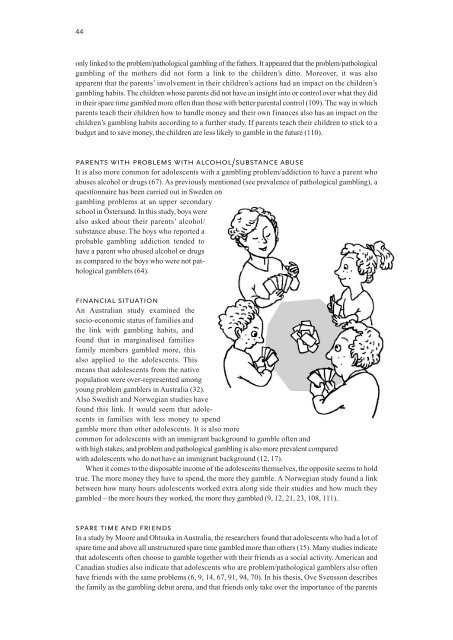Gambling Among Young People, 837 kB
Gambling Among Young People, 837 kB
Gambling Among Young People, 837 kB
You also want an ePaper? Increase the reach of your titles
YUMPU automatically turns print PDFs into web optimized ePapers that Google loves.
44<br />
only linked to the problem/pathological gambling of the fathers. It appeared that the problem/pathological<br />
gambling of the mothers did not form a link to the children’s ditto. Moreover, it was also<br />
apparent that the parents’ involvement in their children’s actions had an impact on the children’s<br />
gambling habits. The children whose parents did not have an insight into or control over what they did<br />
in their spare time gambled more often than those with better parental control (109). The way in which<br />
parents teach their children how to handle money and their own finances also has an impact on the<br />
children’s gambling habits according to a further study. If parents teach their children to stick to a<br />
budget and to save money, the children are less likely to gamble in the future (110).<br />
parents with problems with alcohol/substance abuse<br />
It is also more common for adolescents with a gambling problem/addiction to have a parent who<br />
abuses alcohol or drugs (67). As previously mentioned (see prevalence of pathological gambling), a<br />
questionnaire has been carried out in Sweden on<br />
gambling problems at an upper secondary<br />
school in Östersund. In this study, boys were<br />
also asked about their parents’ alcohol/<br />
substance abuse. The boys who reported a<br />
probable gambling addiction tended to<br />
have a parent who abused alcohol or drugs<br />
as compared to the boys who were not pathological<br />
gamblers (64).<br />
financial situation<br />
An Australian study examined the<br />
socio-economic status of families and<br />
the link with gambling habits, and<br />
found that in marginalised families<br />
family members gambled more, this<br />
also applied to the adolescents. This<br />
means that adolescents from the native<br />
population were over-represented among<br />
young problem gamblers in Australia (32).<br />
Also Swedish and Norwegian studies have<br />
found this link. It would seem that adolescents<br />
in families with less money to spend<br />
gamble more than other adolescents. It is also more<br />
common for adolescents with an immigrant background to gamble often and<br />
with high stakes, and problem and pathological gambling is also more prevalent compared<br />
with adolescents who do not have an immigrant background (12, 17).<br />
When it comes to the disposable income of the adolescents themselves, the opposite seems to hold<br />
true. The more money they have to spend, the more they gamble. A Norwegian study found a link<br />
between how many hours adolescents worked extra along side their studies and how much they<br />
gambled – the more hours they worked, the more they gambled (9, 12, 21, 23, 108, 111).<br />
spare time and friends<br />
In a study by Moore and Ohtsuka in Australia, the researchers found that adolescents who had a lot of<br />
spare time and above all unstructured spare time gambled more than others (15). Many studies indicate<br />
that adolescents often choose to gamble together with their friends as a social activity. American and<br />
Canadian studies also indicate that adolescents who are problem/pathological gamblers also often<br />
have friends with the same problems (6, 9, 14, 67, 91, 94, 70). In his thesis, Ove Svensson describes<br />
the family as the gambling debut arena, and that friends only take over the importance of the parents

















